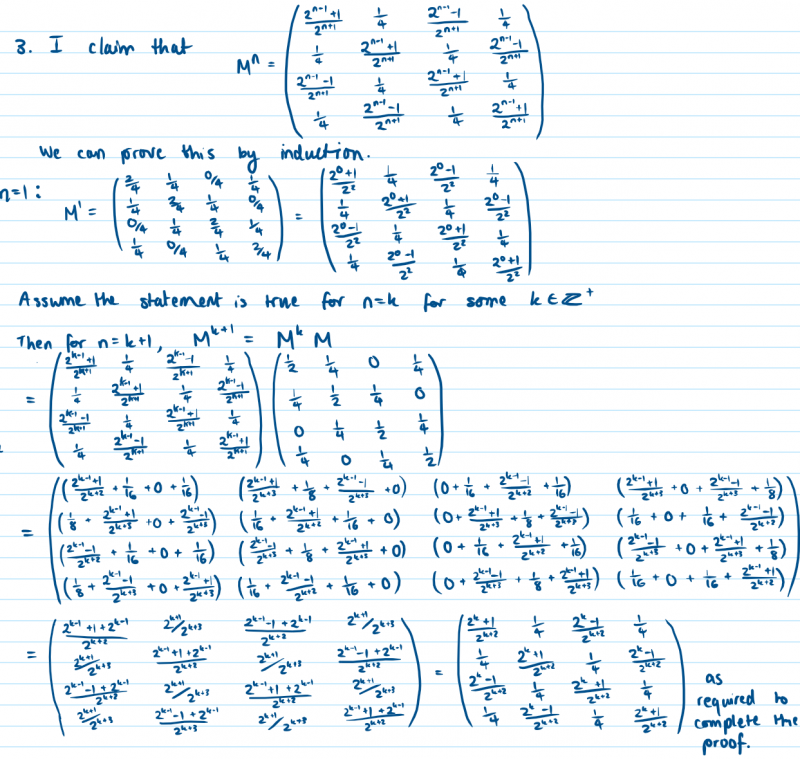Pass the parcel
Problem
You might like to look at the problem Markov Matrices before attempting this problem.
Four children, $A$, $B$, $C$ and $D$, are playing a version of the game "pass the parcel". They stand in a circle, so that $ABCDA$ is the clockwise order. Each time a whistle is blown, the child holding the parcel is supposed to pass the parcel immediately exactly one place clockwise.
In fact each child, independently of any other past event, passes the parcel clockwise with probability $\frac{1}{4}$, passes it anticlockwise with probability $\frac{1}{4}$ and fails to pass it at all with probability $\frac{1}{2}$.
- Write down the transition matrix, ${\bf M}$, for this situation.
- Calculate ${\bf M}^2$, ${\bf M}^3$ and ${\bf M}^4$ (you can use a calculator or online matrix multiplier to help you!).
- Suggest a general form for ${\bf M}^n$.
- If the game starts with child $A$ holding the parcel, work out the probabilities that after $n$ whistle blasts $A$ is holding the parcel. Find also the probabilities that $B$, $C$ and $D$ are holding the parcel.
- What can you say about the probabilities that each child is holding the parcel after a long time (so as $n \to \infty)$?
You may find these Matrix Power calculators useful:
There are more matrix problems in this feature.
Based on STEP Mathematics 2, 2018, Q13. Question reproduced by kind permission of Cambridge Assessment Group Archives. The question remains Copyright University of Cambridge Local Examinations Syndicate ("UCLES"), All rights reserved.
Student Solutions
Tanish from Pate's Grammar School, Nishad from Rugby High School and Leona, all in the UK, found the transition matrix ${\bf M}$ and ${\bf M}^2$, ${\bf M}^3$ and ${\bf M}^4,$ as well as suggesting a formula for the general form ${\bf M}^n.$ This is Leona's work:

Tanish showed where the formula for ${\bf M}^n$ came from, and expressed it in a slightly different form:

Nishad used proof by induction to prove that this formula works for all values of $n.$ Click to see Nishad's proof.
Tanish used $\bf{M}^n$ to find the probability that, after $n$ whistle blasts, child A is holding the parcel:
If the game starts with child A holding the parcel, we can use the first column of the matrix above to find the probability that A, B, C or D are holding the parcel after $n$ whistles.
Leona and Nishad used matrix multiplication to get the same result. This is Leona's work:

To find these probabilities as $n\rightarrow\infty,$ Leona and Tanish used Tanish's formula. This is Leona's work:

Nishad used a different method:

Teachers' Resources
This problem follows on from Markov Matrices, and shows an application of the Markov Matrix method, applied to a popular childrens party game.
Students might like to use these Matrix Power calculators:
For spotting the general form of ${\bf M}^n$, the Matrix Power Calculator (fraction version) will probably be more helpful!
The set up of this question has been taken from a STEP question, but it has been adapted to use matrices. The original STEP question was:
Four children, $A$, $B$, $C$ and $D$, are playing a version of the game `pass the parcel'. They stand in a circle, so that $ABCDA$ is the clockwise order. Each time a whistle is blown, the child holding the parcel is supposed to pass the parcel immediately exactly one place clockwise. In fact each child, independently of any other past event, passes the parcel clockwise with probability $\frac{1}{4}$, passes it anticlockwise with probability $\frac{1}{4}$ and fails to pass it at all with probability $\frac{1}{2}$. At the start of the game, child $A$ is holding the parcel.
The probability that child $A$ is holding the parcel just after the whistle has been blown for the $n$th time is $A_n$, and $B_n$, $C_n$ and $D_n$ are defined similarly.
- Find $A_1$, $B_1$, $C_1$ and $D_1$. Find also $A_2$, $B_2$, $C_2$ and $D_2$.
- By first considering $B_{n+1}+D_{n+1}$, or otherwise, find $B_n$ and $D_n$.
Find also expressions for $A_n$ and $C_n$ in terms of $n$.
There are more matrix problems in this feature.

